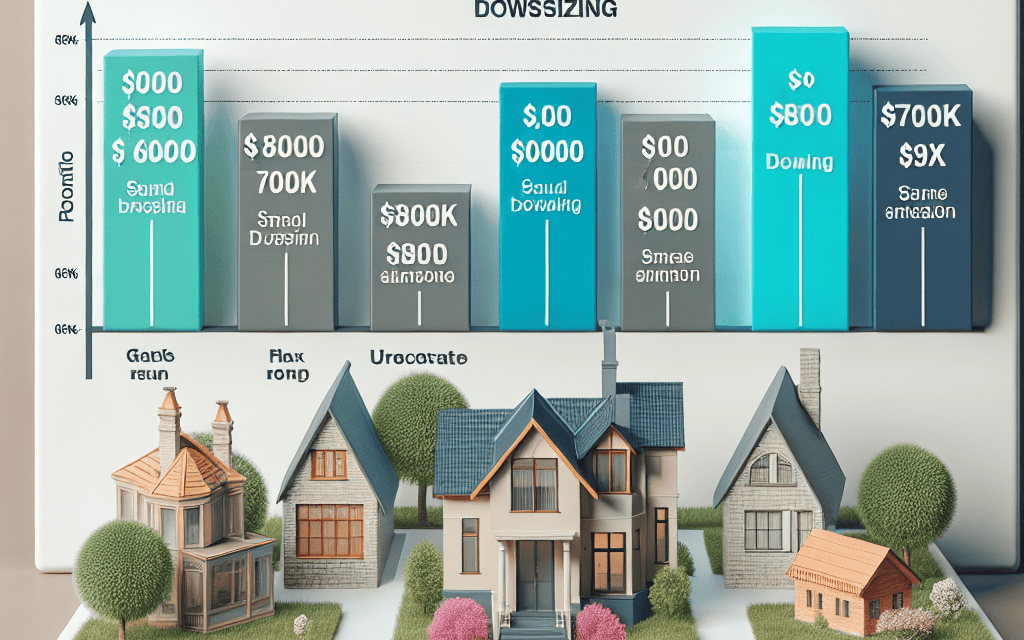“Maximize Your Move: Discover Tax-Free Strategies for Downsizing with $800k Profit”
Introduction
Exploring tax-free options for downsizing after selling a house with an $800,000 profit involves strategic financial planning to maximize the benefits of your real estate gains. As homeowners look to transition into smaller, more manageable living spaces, understanding the tax implications of such a significant profit is crucial. The U.S. tax code offers several avenues to potentially minimize or eliminate capital gains taxes, such as the primary residence exclusion, which allows individuals to exclude up to $250,000 ($500,000 for married couples) of the gain from the sale of a primary residence. Additionally, reinvesting in a new property or utilizing tax-advantaged accounts can further optimize financial outcomes. By carefully navigating these options, homeowners can effectively manage their wealth and achieve a seamless transition into their next phase of living.
Understanding Capital Gains Tax Exemptions for Home Sellers
When considering the financial implications of selling a home, particularly with a substantial profit, understanding capital gains tax exemptions becomes crucial. For homeowners who have recently sold their property and are contemplating downsizing, the prospect of managing an $800,000 profit can be both exciting and daunting. However, the U.S. tax code offers several provisions that can help mitigate the tax burden associated with such a significant gain, allowing sellers to maximize their financial benefits.
One of the most significant tax advantages available to home sellers is the capital gains tax exclusion. Under the current tax laws, if you have owned and lived in your home as your primary residence for at least two of the five years preceding the sale, you may qualify for an exclusion of up to $250,000 of capital gains if you are single, or up to $500,000 if you are married and filing jointly. This exclusion can significantly reduce or even eliminate the taxable portion of your profit, depending on your specific circumstances.
To illustrate, if you are married and your profit from the sale is $800,000, you can exclude $500,000 from taxation, leaving $300,000 subject to capital gains tax. This exclusion is a powerful tool for homeowners, as it allows them to retain a larger portion of their earnings, which can be particularly beneficial when planning to downsize or reinvest in a new property.
Moreover, it is essential to consider the timing of your sale and any potential future sales. The capital gains exclusion can only be claimed once every two years. Therefore, if you anticipate selling another property within this timeframe, strategic planning is necessary to optimize your tax benefits. Additionally, keeping thorough records of home improvements and expenses can further enhance your ability to reduce taxable gains, as these costs can be added to the original purchase price of the home, effectively lowering the capital gain.
For those looking to downsize, reinvesting the proceeds from the sale into a new, smaller home can also offer financial advantages. By purchasing a less expensive property, you can potentially reduce ongoing expenses such as property taxes, maintenance, and utilities, thereby increasing your overall financial flexibility. Furthermore, the remaining profit can be allocated towards other investments or savings, providing a cushion for future needs or retirement.
Another option to consider is a 1031 exchange, which allows you to defer capital gains taxes by reinvesting the proceeds from the sale into a similar type of property. While traditionally used for investment properties, this strategy can be beneficial if you are considering purchasing a rental property or another form of real estate investment. However, it is important to note that 1031 exchanges come with specific requirements and timelines, so consulting with a tax professional is advisable to ensure compliance and maximize benefits.
In conclusion, understanding and utilizing capital gains tax exemptions can significantly impact the financial outcome of selling a home with a substantial profit. By taking advantage of available exclusions, considering strategic reinvestment options, and seeking professional guidance, homeowners can effectively manage their tax liabilities and make informed decisions about downsizing. This approach not only preserves more of the hard-earned profit but also sets the stage for a financially secure future.
Investing in a 1031 Exchange: A Tax-Deferred Strategy
When considering the financial implications of selling a home, particularly one that yields a substantial profit, it is crucial to explore strategies that can mitigate the tax burden associated with such a transaction. One effective method for deferring taxes on the profit from a home sale is through a 1031 exchange, a provision in the U.S. tax code that allows investors to defer capital gains taxes when they reinvest the proceeds from the sale of a property into a similar, or “like-kind,” property. This strategy can be particularly advantageous for those looking to downsize while preserving their investment capital.
To begin with, a 1031 exchange, named after Section 1031 of the Internal Revenue Code, is primarily used by real estate investors to defer capital gains taxes. However, it is important to note that this option is available only for investment or business properties, not personal residences. Therefore, if the property being sold was used as a primary residence, the homeowner must first convert it into an investment property to qualify for a 1031 exchange. This can be achieved by renting out the property for a period, typically at least a year, before initiating the exchange process.
Once the property qualifies as an investment property, the next step involves identifying a replacement property that meets the “like-kind” criteria. The term “like-kind” is broadly interpreted, allowing for a wide range of real estate investments, from residential rental properties to commercial buildings. The key requirement is that the replacement property must be of equal or greater value than the property sold, ensuring that the entire profit is reinvested and thus deferring the capital gains tax.
Timing is a critical factor in executing a 1031 exchange. The Internal Revenue Service (IRS) mandates strict timelines: the seller has 45 days from the sale of the original property to identify potential replacement properties and 180 days to complete the purchase of the new property. These deadlines are non-negotiable, and failure to adhere to them can result in the disqualification of the exchange, leading to immediate tax liabilities.
Moreover, it is essential to engage the services of a qualified intermediary, a neutral third party who facilitates the exchange process. The intermediary holds the proceeds from the sale of the original property and uses them to acquire the replacement property on behalf of the investor. This step is crucial, as direct receipt of the sale proceeds by the seller can invalidate the 1031 exchange.
While a 1031 exchange offers significant tax deferral benefits, it is not without its complexities and potential pitfalls. Investors must carefully consider their long-term investment goals and the suitability of the replacement property. Additionally, it is advisable to consult with tax professionals and real estate advisors to navigate the intricacies of the exchange process and ensure compliance with IRS regulations.
In conclusion, for those contemplating downsizing after selling a home with a substantial profit, a 1031 exchange presents a viable option to defer capital gains taxes while reinvesting in a new property. By understanding the eligibility requirements, adhering to strict timelines, and seeking professional guidance, investors can effectively leverage this tax-deferred strategy to optimize their real estate portfolio and achieve their financial objectives.
Utilizing the Primary Residence Exclusion for Tax Savings
When considering the financial implications of selling a primary residence, particularly with a substantial profit such as $800,000, it is crucial to explore tax-saving strategies that can maximize the benefits of this transaction. One of the most effective methods to achieve this is by utilizing the primary residence exclusion, a provision in the U.S. tax code that allows homeowners to exclude a significant portion of the capital gains from the sale of their home. This exclusion can be a valuable tool for those looking to downsize without incurring a hefty tax burden.
To begin with, the primary residence exclusion permits single homeowners to exclude up to $250,000 of capital gains from their taxable income, while married couples filing jointly can exclude up to $500,000. This exclusion is applicable provided certain conditions are met. The homeowner must have owned and used the property as their primary residence for at least two of the five years preceding the sale. It is important to note that these two years do not need to be consecutive, offering some flexibility for those who may have temporarily relocated or rented out their home.
In the context of selling a home with an $800,000 profit, understanding how the primary residence exclusion applies is essential. For a married couple, the exclusion of $500,000 would reduce the taxable gain to $300,000. For a single homeowner, the exclusion would leave $550,000 subject to capital gains tax. Therefore, the exclusion significantly mitigates the tax liability, making it a pivotal consideration in the decision-making process.
Moreover, it is worth exploring additional strategies that can complement the primary residence exclusion. For instance, if the homeowner has made substantial improvements to the property, these costs can be added to the original purchase price, effectively increasing the basis and reducing the taxable gain. Keeping meticulous records of such improvements is vital, as they can provide further tax relief when selling the home.
Furthermore, timing the sale strategically can also play a role in optimizing tax savings. If the homeowner anticipates a change in tax rates or personal income levels, aligning the sale with a more favorable tax environment could enhance the financial outcome. Consulting with a tax professional can provide personalized insights into the best timing for the sale, taking into account both current tax laws and future projections.
In addition to these strategies, considering the broader financial landscape is advisable. For those planning to downsize, reinvesting the proceeds from the sale into a new, smaller property can offer further financial benefits. This approach not only provides a new living arrangement that suits the homeowner’s current needs but also potentially offers opportunities for future appreciation and tax advantages.
In conclusion, the primary residence exclusion is a powerful tool for homeowners looking to downsize after selling their home with a significant profit. By understanding and applying this exclusion, along with other complementary strategies, homeowners can effectively manage their tax liability and make informed decisions that align with their financial goals. As always, seeking guidance from a tax professional is recommended to ensure compliance with tax regulations and to tailor strategies to individual circumstances.
Exploring Opportunity Zones for Tax-Free Investment

Exploring opportunity zones for tax-free investment can be an advantageous strategy for individuals looking to downsize after selling their homes, especially when realizing a significant profit, such as $800,000. The concept of opportunity zones was introduced as part of the Tax Cuts and Jobs Act of 2017, aiming to stimulate economic development and job creation in distressed communities by offering tax incentives to investors. For those who have recently sold a property and are considering downsizing, investing in opportunity zones presents a unique chance to defer, reduce, or even eliminate capital gains taxes.
To begin with, understanding the mechanics of opportunity zones is crucial. These zones are designated areas across the United States where investors can receive preferential tax treatment. By reinvesting capital gains into a Qualified Opportunity Fund (QOF), investors can defer taxes on those gains until the end of 2026 or until the investment is sold, whichever comes first. Moreover, if the investment is held for at least five years, there is a 10% exclusion of the deferred gain. Holding the investment for seven years increases the exclusion to 15%. Most notably, if the investment is maintained for at least ten years, any additional gains accrued from the opportunity zone investment itself are entirely tax-free.
For individuals who have recently sold their homes and are contemplating downsizing, this presents a compelling opportunity. The $800,000 profit from the sale can be strategically reinvested into a QOF, allowing the seller to defer capital gains taxes and potentially benefit from the aforementioned exclusions. This approach not only provides a tax-efficient way to manage the proceeds from the sale but also contributes to the revitalization of economically challenged areas.
However, it is essential to conduct thorough research before committing to an opportunity zone investment. Not all opportunity zones are created equal, and the success of the investment largely depends on the specific location and the projects being funded. Investors should evaluate the economic potential of the zone, the track record of the fund managers, and the nature of the projects being undertaken. This due diligence ensures that the investment aligns with both financial goals and risk tolerance.
Furthermore, it is advisable to consult with financial advisors or tax professionals who are well-versed in opportunity zone regulations. These experts can provide valuable insights into the complexities of the investment, helping to navigate the legal and tax implications effectively. They can also assist in structuring the investment to maximize tax benefits while aligning with long-term financial objectives.
In addition to the tax advantages, investing in opportunity zones can also be a socially responsible choice. By directing capital into these areas, investors contribute to community development, job creation, and economic growth. This dual benefit of financial gain and social impact can be particularly appealing to those who wish to make a positive difference with their investments.
In conclusion, for individuals who have recently sold their homes and are exploring tax-free options for downsizing, opportunity zones offer a promising avenue. By reinvesting capital gains into these designated areas, investors can defer taxes, potentially reduce their tax liability, and even eliminate future gains from taxation. With careful research and professional guidance, opportunity zone investments can serve as a strategic component of a broader financial plan, providing both economic and social returns.
Benefits of Contributing to a Roth IRA with Home Sale Proceeds
When considering the financial implications of downsizing after selling a home, particularly with a substantial profit such as $800,000, it is crucial to explore tax-efficient strategies to maximize the benefits of this windfall. One such strategy involves contributing to a Roth IRA, which offers several advantages for individuals looking to secure their financial future. By understanding the benefits of a Roth IRA, homeowners can make informed decisions that align with their long-term financial goals.
Firstly, a Roth IRA provides the opportunity for tax-free growth, which is a significant advantage for those who have recently realized a large profit from a home sale. Unlike traditional IRAs, contributions to a Roth IRA are made with after-tax dollars, meaning that the money invested grows tax-free over time. This feature is particularly beneficial for individuals who anticipate being in a higher tax bracket during retirement, as it allows them to withdraw funds without incurring additional tax liabilities. Consequently, the tax-free growth potential of a Roth IRA can significantly enhance the overall value of the investment, making it an attractive option for those looking to preserve their wealth.
Moreover, Roth IRAs offer flexibility in terms of withdrawals, which can be particularly advantageous for individuals who have recently downsized and may require access to their funds. Unlike traditional retirement accounts, Roth IRAs do not impose required minimum distributions (RMDs) during the account holder’s lifetime. This means that individuals can allow their investments to grow for as long as they wish, without being forced to withdraw funds at a specific age. This flexibility can be especially beneficial for those who wish to leave a financial legacy for their heirs, as it allows the account to continue growing tax-free over an extended period.
In addition to the tax-free growth and flexible withdrawal options, contributing to a Roth IRA can also serve as a strategic estate planning tool. Since Roth IRA contributions are made with after-tax dollars, the account can be passed on to beneficiaries without incurring income taxes. This feature can be particularly appealing for individuals who wish to provide for their loved ones while minimizing the tax burden on their estate. By incorporating a Roth IRA into their estate planning strategy, homeowners can ensure that their financial legacy is preserved and passed on efficiently.
Furthermore, the ability to contribute to a Roth IRA is not limited by age, making it an accessible option for individuals at various stages of life. As long as the account holder has earned income, they can continue to contribute to their Roth IRA, thereby maximizing their retirement savings. This aspect is particularly relevant for those who have recently downsized and may still be working or generating income from other sources. By taking advantage of this opportunity, individuals can continue to build their retirement nest egg, ensuring financial security in their later years.
In conclusion, contributing to a Roth IRA with the proceeds from a home sale offers numerous benefits that can enhance an individual’s financial well-being. The tax-free growth potential, flexible withdrawal options, and estate planning advantages make it an attractive option for those looking to maximize the value of their investment. By carefully considering these benefits, homeowners can make informed decisions that align with their long-term financial goals, ensuring a secure and prosperous future.
Gifting Real Estate Profits to Family Members Tax-Free
When considering the financial implications of downsizing after selling a house, particularly with a substantial profit such as $800,000, it is crucial to explore tax-efficient strategies. One such strategy involves gifting real estate profits to family members, which can be a viable option for those looking to share their wealth while minimizing tax liabilities. Understanding the nuances of this approach requires a careful examination of the current tax laws and regulations governing gifts.
To begin with, the Internal Revenue Service (IRS) allows individuals to gift a certain amount of money or assets to others each year without incurring a gift tax. As of 2023, the annual gift tax exclusion is $17,000 per recipient. This means that you can give up to $17,000 to as many individuals as you wish without having to pay any gift tax. For a couple, this amount doubles, allowing them to gift up to $34,000 per recipient annually. Therefore, if you are considering distributing your $800,000 profit among family members, this exclusion can be a useful tool.
Moreover, it is important to consider the lifetime gift and estate tax exemption, which is set at $12.92 million per individual in 2023. This exemption allows you to give away a substantial amount of money or assets over your lifetime without incurring federal gift taxes. If your total gifts exceed the annual exclusion, the excess amount will count against your lifetime exemption. However, given the current high exemption threshold, many individuals can effectively transfer significant wealth to their family members without triggering gift taxes.
In addition to understanding these tax exclusions and exemptions, it is essential to consider the implications of gifting real estate profits on your overall financial plan. Gifting can be a strategic way to reduce the size of your taxable estate, potentially lowering future estate taxes. However, it is crucial to ensure that you maintain sufficient resources for your own financial security and retirement needs. Consulting with a financial advisor or tax professional can provide valuable insights into how gifting fits into your broader financial strategy.
Furthermore, when gifting substantial amounts, it is advisable to document the transactions carefully. This includes keeping records of the amounts gifted, the recipients, and the dates of the gifts. Proper documentation can help avoid any misunderstandings or disputes with the IRS and ensure that the gifts are recognized as legitimate transfers.
It is also worth noting that while federal gift tax laws provide significant opportunities for tax-free gifting, state laws may vary. Some states have their own gift tax regulations, which could impact your gifting strategy. Therefore, it is important to be aware of the specific laws in your state and how they might affect your plans.
In conclusion, gifting real estate profits to family members can be an effective way to share your wealth while minimizing tax liabilities. By taking advantage of the annual gift tax exclusion and the lifetime gift and estate tax exemption, you can transfer significant assets without incurring federal gift taxes. However, it is essential to consider the broader implications of gifting on your financial plan and to consult with professionals to ensure that your strategy aligns with your long-term goals. With careful planning and consideration, you can successfully navigate the complexities of gifting and make the most of your real estate profits.
Charitable Donations: Reducing Tax Liability with Home Sale Profits
When considering the financial implications of selling a home, particularly one that results in a substantial profit, it is crucial to explore strategies that can mitigate the associated tax liabilities. For individuals who have recently sold their house and realized a profit of $800,000, the prospect of downsizing can be both an exciting and daunting financial transition. One effective method to reduce tax liability while simultaneously contributing to the greater good is through charitable donations. By strategically allocating a portion of the home sale profits to charitable organizations, individuals can not only support causes they are passionate about but also benefit from significant tax deductions.
To begin with, understanding the tax benefits associated with charitable donations is essential. The Internal Revenue Service (IRS) allows taxpayers to deduct contributions made to qualified charitable organizations from their taxable income. This deduction can be particularly advantageous for those who have experienced a windfall from a home sale, as it can significantly lower the amount of taxable income and, consequently, the overall tax burden. It is important to note that the IRS imposes certain limitations on the amount that can be deducted, typically up to 60% of the taxpayer’s adjusted gross income (AGI) for cash donations. Therefore, careful planning and consultation with a tax professional are advisable to maximize the benefits.
Moreover, the choice of charitable organizations plays a pivotal role in optimizing tax deductions. Contributions must be made to IRS-recognized 501(c)(3) organizations to qualify for tax deductions. These organizations encompass a wide range of causes, including education, healthcare, environmental conservation, and social services, among others. By selecting organizations that align with personal values and interests, individuals can ensure that their donations have a meaningful impact while also fulfilling the necessary criteria for tax deductions.
In addition to direct cash donations, there are other charitable giving strategies that can further enhance tax benefits. For instance, establishing a donor-advised fund (DAF) allows individuals to make a charitable contribution, receive an immediate tax deduction, and then recommend grants from the fund over time. This approach provides flexibility in terms of timing and allows for a more strategic distribution of funds to various charitable causes. Furthermore, donating appreciated assets, such as stocks or mutual funds, can offer dual benefits: avoiding capital gains taxes on the appreciated value and receiving a tax deduction for the full fair market value of the asset.
Transitioning from the financial aspects, it is equally important to consider the personal and societal impacts of charitable giving. By directing a portion of home sale profits towards charitable causes, individuals can contribute to positive change in their communities and beyond. This act of giving not only supports organizations in need but also fosters a sense of fulfillment and purpose. It is a powerful way to transform financial success into meaningful contributions that can have a lasting impact.
In conclusion, for those contemplating downsizing after selling a home with a significant profit, exploring tax-free options through charitable donations presents a compelling opportunity. By understanding the tax benefits, selecting appropriate charitable organizations, and considering various giving strategies, individuals can effectively reduce their tax liability while making a positive difference in the world. As with any financial decision, consulting with a tax advisor is recommended to ensure compliance with IRS regulations and to tailor a strategy that aligns with personal financial goals and philanthropic aspirations.
Q&A
1. **What is a 1031 Exchange?**
A 1031 Exchange allows you to defer capital gains taxes by reinvesting the proceeds from the sale of your property into a similar property within a specific timeframe.
2. **Can I use a Roth IRA for tax-free growth?**
Yes, contributions to a Roth IRA are made with after-tax dollars, and qualified withdrawals, including earnings, are tax-free.
3. **What is the primary residence exclusion?**
If you have lived in your home for at least two of the last five years, you can exclude up to $250,000 ($500,000 for married couples) of the profit from capital gains tax.
4. **How can I invest in municipal bonds?**
Municipal bonds are debt securities issued by states, municipalities, or counties, and the interest earned is often exempt from federal and sometimes state and local taxes.
5. **What is a Health Savings Account (HSA)?**
An HSA allows you to save money for medical expenses with pre-tax dollars, and withdrawals for qualified medical expenses are tax-free.
6. **Can I gift money to family members tax-free?**
Yes, you can gift up to $17,000 per recipient per year (as of 2023) without incurring gift tax, and this amount is adjusted for inflation.
7. **What is a Charitable Remainder Trust (CRT)?**
A CRT allows you to donate assets, receive a partial tax deduction, and generate income for a specified period, with the remainder going to charity.
Conclusion
Exploring tax-free options for downsizing after selling your house with an $800k profit involves understanding and utilizing various tax strategies and exemptions. One primary consideration is the capital gains tax exclusion, which allows you to exclude up to $250,000 of profit ($500,000 for married couples filing jointly) from the sale of your primary residence, provided you meet certain ownership and use criteria. Beyond this exclusion, you might consider reinvesting the proceeds into a new primary residence, potentially deferring taxes through a 1031 exchange if the properties qualify as investment properties. Additionally, contributing to retirement accounts like IRAs or 401(k)s, if eligible, can offer tax advantages. Consulting with a tax professional is crucial to tailor these strategies to your specific financial situation and ensure compliance with IRS regulations. Ultimately, careful planning and strategic reinvestment can help maximize the benefits of your profit while minimizing tax liabilities.




